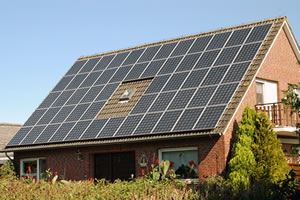 December 14, 2011—As the US has launched an anti-dumping investigation of China’s solar products, the Chinese PV industry is taking steps towards self-preservation – Taiwanese vendors will reap the benefits of these measures, and will likely see increased sales.
December 14, 2011—As the US has launched an anti-dumping investigation of China’s solar products, the Chinese PV industry is taking steps towards self-preservation – Taiwanese vendors will reap the benefits of these measures, and will likely see increased sales.
According to statistics from EnergyTrend, a research division of TrendForce, module products from China account for over 50% of the U.S. market. The remainder comes from Japan, Korea, and Europe, and these countries will benefit once the anti-dumping investigation is approved. However, the benefit to Taiwanese PV module makers will be minimal, as they are limited by production scale as well as brand image. Furthermore, as solar cells, mainly produced in China, Europe, and Taiwan, account for 10% of solar products imported to the U.S., once countervailing duties are imposed on Chinese products, Taiwanese PV cell makers will benefit either from transferred or direct orders.
According to EnergyTrend, recently Chinese vendors have sought out Taiwanese vendors for cooperation; for instance, top-tier Chinese vendors have already begun preliminary negotiations regarding solar cell and module ODM / OEM. However, EnergyTrend indicates that as price offers have remained relatively low, Taiwanese vendors are not yet eager to accept orders.
Though transferred orders may bring out more positive market expectations, Taiwanese wafer and cell makers revenue performance varied, according to the latest financial results released in November. Affected by the persisting price downtrend and stagnant demand, a number of companies underwent huge setbacks in their revenues. However, certain companies’ revenue increased due to increased OEM orders, resale of raw material and inventory digestion.
As for the outlook in December, many manufacturers’ shipments will continue to fall, which is attributed to their strategies of deliberately accepting select clients’ orders to maintain prices. In addition, the solar market remains in a slump and the small amount of year-end rush orders are already in place. Therefore, based on the low utilization rate at present, despite the minor revenue contribution brought about by certain manufacturers’ inventory digestion and the long-term partnerships on material supply, the contribution of wafer and cell production can bring to the total revenues is limited. Moreover, in response to the conservative trend that dominated the solar market, many manufacturers have begun optimizing manufacturing process and seeking to join forces with upstream and downstream players, in the hope of spurring growth in 2012.

Source: EnergyTrend
Compared to October revenues, Solartech Energy’s November revenue suffered the biggest downturn, fell by 46.3%, while November revenues of Motech, Sino-American Silicon Products and Gintech dipped by 33.8%, 32.9% and 10.2%, respectively. Green Energy Technology’s November revenue increased 15.4% MoM, and Neo Solar Power’s remained similar to its October revenue.
As for this week’s spot prices, polysilicon, Si wafer, and solar cell price all remain on a downtrend, but the price decline has slowed. As for spot market prices, lowest polysilicon price fell to US$20/kg, but transaction volume was low. Polysilicon ASP fell to US$23.98/kg, a decrease of 2.36%. In terms of Si wafers, lowest multi-Si wafer price remained at US$1.05/piece, while lowest mono-Si wafer price stayed at US$1.48/piece. This week’s multi-Si wafer ASP fell to US$1.119/piece, a decrease of 1.06%, while mono-Si wafer ASP dropped to US$1.570/piece, a 0.95% decrease. As for solar cells, this week’s prices show signs of a stabilization, with lowest solar cell price at US$0.47/Watt, while ASP was $0.511/Watt, a 0% decrease. In terms of modules, lowest PV module price was approximately US$0.7/Watt, while ASP fell by 2.27% to US$0.861/Watt. Furthermore, affected by the module price decrease, thin film ASP fell as well, by 1.07% to US$0.829.

 Alternative Energy HQ solar power for homes, wind energy, and bio fuel issues
Alternative Energy HQ solar power for homes, wind energy, and bio fuel issues





